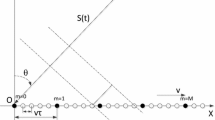Abstract
A robust and high-resolution deconvolution algorithm based on coordinate correction is developed for a compact conformal array on a three-dimensional (3D) moving platform such as underwater glider. First, the coordinate-correcting conventional beamforming is derived to directly estimate the azimuth of the long-range targets in the geodesic coordinate system for a 3D moving platform array. Then, we improve the extended Richardson–Lucy deconvolution (Ex-RL-dCv) beamforming algorithm utilizing coordinate correction to simplify the bearing estimation model from two-dimensional (2D) to one-dimensional (1D). The improved algorithm corrects the deconvolution point spread function (PSF) dictionary mismatch caused by the platform’s 3D motion, and has lower sidelobes compared with the Ex-RL-dCv algorithm without coordinate correction. Finally, simulations and results from field-trial data processing are presented. The results demonstrate that the improved Ex-RL-dCv beamforming based on coordinate correction can significantly suppress the high sidelobes caused by deconvolution model mismatch, and successfully realize the robust and high-resolution detection for targets using the compact conformal array on a 3D mobile platform.




















Similar content being viewed by others
References
Sun, D., Ma, C., Yang, T.C., Mei, J., Shi, W.: Improving the performance of a vector sensor line array by deconvolution. IEEE J. Oceanic Eng. 45(3), 1063–1077 (2019). https://doi.org/10.1109/JOE.2019.2912586
Zhao, B., Zhang, W., Ding, H.: A new algorithm for image deblurring based on Richardson-Lucy. Comput. Eng. Appl. 47(34), 1-4P (2011). https://doi.org/10.3778/j.issn.1002−331.2011.34.001
Chu, Z., Yang, Y., He, Y.: Deconvolution for three-dimensional acoustic source identification based on spherical harmonics beamforming. J. Sound Vib. 344, 484–502 (2015). https://doi.org/10.1016/j.jsv.2015.01.047
Yardibi, T., Li, J., Stoica, P., Cattafesta, L.N., III.: Sparsity constrained deconvolution approaches for acoustic source mapping. J. Acoust. Soc. America 123(5), 2631–2642 (2008). https://doi.org/10.1121/1.2896754
Dougherty, R. (2005) Extensions of DAMAS and benefits and limitations of deconvolution in beamforming. In: 11th AIAA/CEAS aeroacoustics conference, https://doi.org/10.2514/6.2005−961
Lylloff, O., Fernández-Grande, E., Agerkvist, F., Hald, J., Tiana Roig, E., Andersen, M.S.: Improving the efficiency of deconvolution algorithms for sound source localization. J. Acoust. Soc. America 138(1), 172–180 (2015). https://doi.org/10.1121/1.4922516
Ehrenfried, K., Koop, L.: Comparison of iterative deconvolution algorithms for the mapping of acoustic sources. AIAA J. 45(7), 1584–1595 (2007). https://doi.org/10.2514/1.26320
Shao, P., Xing, M., Xia, X.G., Li, Y., Li, X., Bao, Z.: Autofocus algorithm using blind homomorphic deconvolution for synthetic aperture radar imaging. IET Radar Sonar Navig. 9(7), 900–906 (2015). https://doi.org/10.1049/iet-rsn.2014.0399
Bose, R., Freedman, A., Steinberg, B.D.: Sequence CLEAN: a modified deconvolution technique for microwave images of contiguous targets. IEEE Trans. Aerosp. Electron. Syst. 38(1), 89–97 (2002). https://doi.org/10.1109/7.993231
Williams, E.G., Maynard, J.D., Skudrzyk, E.: Sound source reconstructions using a microphone array. J. Acoust. Soc. America 68(1), 340–344 (1980). https://doi.org/10.1121/1.384602
Tiana-Roig, E., Jacobsen, F.: Deconvolution for the localization of sound sources using a circular microphone array. J. Acoust. Soc. America 134(3), 2078–2089 (2013). https://doi.org/10.1121/1.4816545
Xenaki, A., Jacobsen, F., Fernandez-Grande, E.: Improving the resolution of three-dimensional acoustic imaging with planar phased arrays. J. Sound Vib. 331(8), 1939–1950 (2012). https://doi.org/10.1016/j.jsv.2011.12.011
Yang, T.C.: Deconvolved conventional beamforming for a horizontal line array. IEEE J. Oceanic Eng. 43(1), 160–172 (2017). https://doi.org/10.1109/JOE.2017.2680818
Yang, T.C.: Performance analysis of superdirectivity of circular arrays and implications for sonar systems. IEEE J. Oceanic Eng. 44(1), 156–166 (2018). https://doi.org/10.1109/JOE.2018.2801144
Sun D, Ma C, Mei J, Shi W, Gao L (2018) The deconvolved conventional beamforming for non-uniform line arrays. In 2018 OCEANS-MTS/IEEE Kobe Techno-Oceans (OTO), IEEE, https://doi.org/10.1109/OCEANSKOBE.2018.8559294
Mei, J., Shi, W., Ma, C., Sun, D.: Near-field focused beamforming acoustic image measurement based on deconvolution. Acta Acustica 45(1), 15–8 (2020). https://doi.org/10.15949/j.cnki.0371−025.2020.01.002
Niu, S.L., Zhang, Z.Y., Hu, Y.M., Ni, M.: Direction of arrival estimation from a single vector hydrophone with attitude correction. J Nat. Univ. Defense Technol. 33(6), 105–110 (2011). https://doi.org/10.3969/j.issn.1001−486.2011.06.018
Richardson, W.H.: Bayesian-based iterative method of image restoration. JoSA 62(1), 55–59 (1972). https://doi.org/10.1364/JOSA.62.000055
Lucy, L.B.: An iterative technique for the rectification of observed distributions. Astron. J. 79, 745 (1974)
Woithe H C, Boehm D, Kremer U. (2011) Improving Slocum Glider dead reckoning using a Doppler Velocity Log. OCEANS'11 MTS/IEEE KONA, https://doi.org/10.23919/OCEANS.2011.6107296
Acknowledgements
This work has been supported by the National Natural Science Foundation of China under Grant No.61871144.
Funding
The Funding was provided by Innovative Research Group Project of the National Natural Science Foundation of China, (No.61871144)
Author information
Authors and Affiliations
Corresponding author
Ethics declarations
Conflict of interest
The authors have no relevant financial or non-financial interests to disclose.
Additional information
Publisher's Note
Springer Nature remains neutral with regard to jurisdictional claims in published maps and institutional affiliations.
Rights and permissions
Springer Nature or its licensor (e.g. a society or other partner) holds exclusive rights to this article under a publishing agreement with the author(s) or other rightsholder(s); author self-archiving of the accepted manuscript version of this article is solely governed by the terms of such publishing agreement and applicable law.
About this article
Cite this article
Sun, D., Zhang, K., Mei, J. et al. Deconvolved Beamforming for a Compact Conformal Array on a Three-dimensional Mobile Platform. Acoust Aust 51, 373–388 (2023). https://doi.org/10.1007/s40857-023-00304-w
Received:
Accepted:
Published:
Issue Date:
DOI: https://doi.org/10.1007/s40857-023-00304-w




